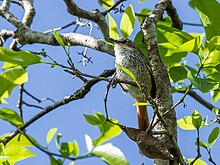| Chinchipe spinetail | |
|---|---|

| |
| Conservation status | |
 Least Concern (IUCN 3.1) | |
| Scientific classification | |
| Domain: | Eukaryota |
| Kingdom: | Animalia |
| Phylum: | Chordata |
| Class: | Aves |
| Order: | Passeriformes |
| Family: | Furnariidae |
| Genus: | Synallaxis |
| Species: | S. chinchipensis |
| Binomial name | |
| Synallaxis chinchipensis Chapman, 1925 | |

| |
The Chinchipe spinetail (Synallaxis chinchipensis) is a species of bird in the family Furnariidae, the ovenbirds. It is endemic to Peru.
Taxonomy and systematics
The Chinchipe spinetail was long considered a subspecies of the necklaced spinetail (Synallaxis stictothorax). Several publications beginning in 2010 described the morphological, vocal, and phylogenetic differences between them. Based on that evidence, the South American Classification Committee of the American Ornithological Society and the International Ornithological Congress elevated it to species rank in January 2021. The Clements taxonomy followed suit in August 2021. The Chinchipe spinetail is monotypic.
Description
The Chinchipe spinetail is 11 to 13 cm (4.3 to 5.1 in) long. It is one of the smallest members of genus Synallaxis. The sexes have the same plumage. Adults have a buffy supercilium on an otherwise blackish face with faint whitish streaks. Their forecrown has black and white streaks. The rest of their crown is dull grayish brown, their back slightly browner, their rump rufescent-brown, and their uppertail coverts bright rufous. The wing has whitish at the bend; the coverts and secondaries are rufous and the primaries dusky. Their tail is bright rufous but for the dark brownish central pair of feathers. Their throat is white, their breast buffy white with black spots, their belly whitish, and their flanks and undertail coverts grayish. Their iris is brown to reddish brown or brownish red, their bill black (sometimes with much gray on the mandible), and their legs and feet blue-gray to dark gray. The juvenile plumage has not been described.
Distribution and habitat
The Chinchipe spinetail is found only in northwestern Peru, in the drainages of Río Marañón and Río Chinchipe in the Department of Cajamarca. It inhabits scrub and the edges of deciduous woods, mostly between 400 and 600 m (1,300 and 2,000 ft) of elevation.
Behavior
Movement
The Chinchipe spinetail is a year-round resident throughout its range.
Feeding
The Chinchipe spinetail's principal foods are arthropods and arthropod larvae. It usually feeds within 1 or 2 m (3 or 7 ft) of the ground, gleaning from moss, leaves, and small branches in pairs or mixed-species flocks.
Breeding
Nothing is known about the Chinchipe spinetail's breeding biology.
|
Songs and calls Listen to Chinchipe spinetail on xeno-canto |
Vocalization
The Chinchipe spinetail's song is a "short rhythmic phrase consisting of a rising trill followed by a loud squeak and a stuttered monotone trill, rendered tr’r’r’r’up-KSEEP’tra’a’a or turree-TYEE-trrree". It also makes a "rattled series of notes...which may go up and down in pace and pitch". Both vocalizations are often given in duet. Pairs sing mostly in the morning and typically from within dense scrub.
Status
The IUCN has assessed the Chinchipe spinetail as being of Least Concern. It has a limited range; its population size is not known but is believed to be stable. No immediate threats have been identified. It appears to be fairly common and to tolerate some habitat degradation.
References
- ^ BirdLife International (2017). "Chinchipe SpinetailSynallaxis chinchipensis". IUCN Red List of Threatened Species. 2017: e.T103675711A112280517. doi:10.2305/IUCN.UK.2017-1.RLTS.T103675711A112280517.en. Retrieved 22 November 2023.
- ^ Gill, Frank; Donsker, David; Rasmussen, Pamela, eds. (July 2023). "Ovenbirds, woodcreepers". IOC World Bird List. v 13.2. Retrieved July 31, 2023.
- Schulenberg, T.S; Stotz, D.F.; Lane, D.F.; O'Neill, J.P.; Parker III, T.A. (2010). Birds of Peru, revised and updated edition. Princeton University Press.
- Tobias, J.A.; Cornwallis, C.K.; Derryberry, E.P.; Claramunt, S.; Brumfield, R.T.; Seddon, N. (2014). "Species coexistence and the dynamics of phenotypic evolution in adaptive radiation". Nature. 506 (7488): 359–363. Bibcode:2014Natur.506..359T. doi:10.1038/nature12874. PMID 24362572.
- Stopiglia, R.; Brockmann, F.A.; de Assis, C.P.; Raposo, M.A. (2020). "Alpha taxonomy of Synallaxis stictothorax group (Aves: Passeriformes: Furnariidae): Synallaxis chinchipensis Chapman, 1925 as a valid species, with a lectotype designation". Vertebrate Zoology. 70: 319–331.
- Remsen, J. V., Jr., J. I. Areta, E. Bonaccorso, S. Claramunt, A. Jaramillo, D. F. Lane, J. F. Pacheco, M. B. Robbins, F. G. Stiles, and K. J. Zimmer. Version 19 January 2021. A classification of the bird species of South America. American Ornithological Society. http://www.museum.lsu.edu/~Remsen/SACCBaseline.htm retrieved January 20, 2021
- Gill, F.; Donsker, D.; Rasmussen, P. (January 2021). "IOC World Bird List (v 11.1)". Retrieved January 14, 2021.
- Clements, J. F., P.C. Rasmussen, T. S. Schulenberg, M. J. Iliff, T. A. Fredericks, J. A. Gerbracht, D. Lepage, A. Spencer, S. M. Billerman, B. L. Sullivan, and C. L. Wood. 2023. The eBird/Clements checklist of birds of the world: v2023. Downloaded from https://www.birds.cornell.edu/clementschecklist/download/ retrieved October 28, 2023
- del Hoyo, J., J. V. Remsen, Jr., G. M. Kirwan, P. F. D. Boesman, and N. Collar (2021). Necklaced Spinetail (Synallaxis stictothorax), version 1.1. In Birds of the World (H. F. Greeney, Editor). Cornell Lab of Ornithology, Ithaca, NY, USA. https://doi.org/10.2173/bow.necspi1.01.1 retrieved November 23, 2023
- ^ del Hoyo, J., J. V. Remsen, Jr., G. M. Kirwan, P. F. D. Boesman, and N. Collar (2021). Chinchipe Spinetail (Synallaxis chinchipensis), version 1.0. In Birds of the World (H. F. Greeney, Editor). Cornell Lab of Ornithology, Ithaca, NY, USA. https://doi.org/10.2173/bow.necspi3.01 retrieved November 23, 2023
| Taxon identifiers | |
|---|---|
| Synallaxis chinchipensis | |
